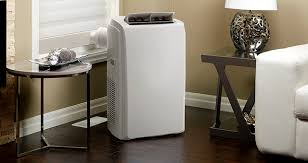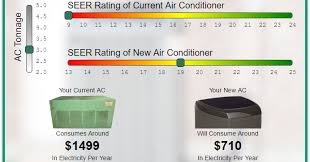5 ton ac btu rating

Calculating chiller and cooling tower refrigeration - in tons Cooling towers tons pairs the water-cooled chiller tons and the water-cooled condenser tons. Chiller Refrigeration Tons The process of cooling is called refrigeration. Refrigeration or cooling capacity can be measured in tons. A water-chiller refrigeration ton is defined as: 1 Refrigeration Ton (RT) = 1 TONScond = 12000 Btu/h = 200 Btu/min = 3025.9 k Calories/h = 12661 kJ/h = 3.517 kW 1 kW = 0.2843 Refrigeration Ton (RT) A ton is the amount of heat removed by an air conditioning system that would melt 1 ton (2000 lbs.) of ice in 24 hours. The heat required to melt 1 lb of ice at 32 oF to water is 144 Btu. 1 Ton Refrigeration = (2000 lb) (144 Btu/lb) / (24 hr) = 12000 Btu/hr Converting between Btu/h and Tons of Refrigeration Btu/h Refrigeration Ton 6000 1/2 12000 1 18000 1 1/2 24000 2 30000 2 1/2 36000 3 42000 3 1/2 48000 4 54000 4 1/2 60000 5 Cooling Tower Tons A cooling tower ton is defined as: 1 cooling tower ton = 1 TONSevap = 1 TONScond x 1.25 = 15000 Btu/h = 3782 k Calories/h = 15826 kJ/h The equivalent ton on the cooling tower side actually rejects about 15000 Btu/h due to the heat-equivalent of the energy needed to drive the chiller's compressor.

This equivalent ton is defined as the heat rejection in cooling 3 U.S. gallons/minute (1500 pound/hour) of water 10°F, which amounts to 15000 Btu/hour, or a chiller coefficient-of-performance (COP) of 4.0 - a COP equivalent to an energy efficiency ratio (EER) of 13.65.
home ac unit hummingHeat Load and Water Flow A water systems heat load in Btu/h can be simplified to: h = cp ρ q dt = (1 Btu/lbm oF) (8.33 lbm/US gal) q (60 min/h) dt = 500 q dt (1) where h = heat load (Btu/h) cp = specific heat, 1 (Btu/lbm oF) for water ρ = 8.33 (lbm/US gal) for water q = water volume flow rate (US gal/min) dt = temperature difference (oF) Example - Water Chiller Cooling Water flows with
goodman hvac unit warranty1 gal/min and 10oF temperature difference.
window ac units freon
The ton of cooling load can be calculated as: Cooling load = 500 (1 US gal/min) (10 oF) / 12000 = ton Converting between heat and energy units Converting kW/tonn to COP or EER en: cooling load tonses: enfriamiento de toneladas de cargade: Kühllast Tonnen Need some Expert Advice? JustAnswer can help you! Talk with a verified expert until your satisfied, 100% money- back guarantee. Search the Engineering ToolBox Engineering ToolBox - SketchUp Extension - Online 3D modeling! Add standard and customized parametric components - like flange beams, lumbers, piping, stairs and more - to your Engineering ToolBox - SketchUp Extension/Plugin - enabled for use with the amazing, fun and freeAdd the Engineering ToolBox extension to your SketchUp from the Sketchup Extension Warehouse!You are here » Room Air Conditioners AC BTU Rating Help Hoping for some help on an AC compressor BTU rating. It appears to me to be a 3-ton, but I am unable to find confirmation from any of my references.

It is a 2007 Carrier unit with a model number of: 24ABR360A350 and a serial number of 3607E12775. Re: AC BTU Rating Help 24 = A/C (i.e. as opposed to a #25 heat pump) B = Tier - base (whatever that means) R = R22 (A=Puron) 3= SEER designation, 3=13, 4=14, etc 60 = 60,000 btu = 5 tons A = standard variations 3 = 208/230 1ph mfg = 36th week of 2007 Mike Boyett, TREC #7290 (Retired) BB code is On [IMG] code is On Become a Certified Home Energy Rating Field Inspector in South Carolina. Help with Amp ratingPortable air conditioners are great cooling options for rooms and apartments without access to central AC. They're easy to install, add instant cooling, and come with tons of features for simple operation. But you should consider these 5 things before purchasing a portable AC for your home or office. Portable air conditioners are rated in British Thermal Units (BTUs) per hour. Models with higher BTU ratings offer more cooling power and can cover larger rooms.

It's important to buy a portable AC that's appropriate for your space to make sure you don't waste energy or waste your money on one that can't adequately cool your room. In a standard room with 8-foot ceilings, use these estimations: Note: The guidelines above are not exact. Environmental factors may increase or decrease the number of BTUs required. For example, rooms with poor insulation or heat-producing appliances will require models with slightly more BTUs. If you have any questions about what size you should buy, feel free to call us at 1-800-934-9194. During the cooling process, portable ACs produce hot air that must be exhausted out of their hose (or hoses). All the models we sell come with an included window kit to expel the warm air outside. This means most portable ACs need to plugged in within a few feet of a window. Placing them next to a window in the easiest and quickest way to install them, but you do have other options. For more information, check out our How to Vent Your Portable AC article.

Additionally, some commercial ACs, like Movincool portable air conditioners, are available with installation kits that allow the hot air to vent out through a drop ceiling or an adjacent wall. The only maintenance you really have to worry about is draining collected moisture. All portable ACs pull moisture out of the air as the cool; it's just part of the process. There are multiple ways to get rid of this moisture: Manually remove the pan and empty it as needed, attach a hose for gravity draining to a different location, or use a pump to push water up and out of the AC and into another location. The most hassle-free portable ACs, however, feature fully self-evaporative designs. These models, such as the unique line of DeLonghi air conditioners and the efficient Whynter portable ACs, evaporate all or most of the water they collect. Since the moisture is automatically removed, you won't have to worry about draining them, and if you do, it's only occasionally. Check out our article discussing fully self-evaporative portable AC brands for more information.

You'll also need to clean filters as directed and defrost the unit fully if ice builds up on the coils. Other than that, most PACs offer a "set it and forget it" approach to maintenance. Portable ACs do create noise in your space. They're working to cool your space, and unlike window ACs, their entire bodies are housed inside your room. Any machine that generates airflow is going to produce some level of noise. If you're concerned about the noise level, be sure to compare the decibel (dB) levels produced by different units. Soleus Air portable air conditioners, for instance, are among the quieter models on the market, reaching 45 dBs on their highest settings. If you're concerned about the noise level in your home, call us at 1-800-934-9194. We can point you in the right direction. If you're concerned about energy efficiency (for the sake of the environment and/or your monthly energy bills), then you should look at a PAC’ s Energy Efficiency Ratio (EER). The EER tells you how many BTUs are used for each watt of power.